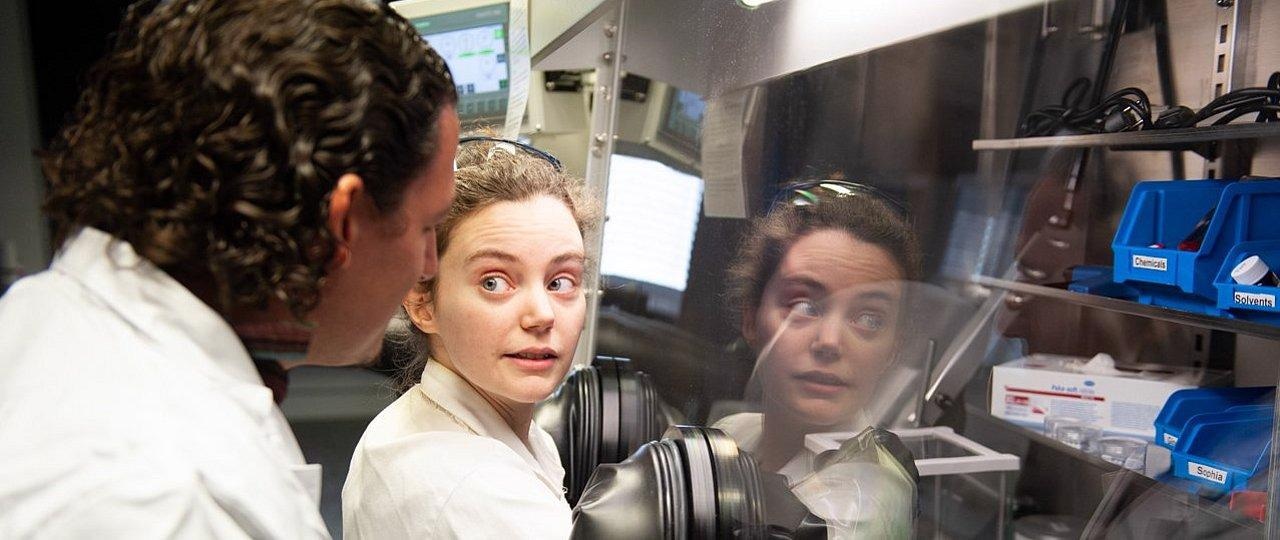Reviewed by Alex SmithMay 10 2022
Electrochemical cells that emit light can be used to develop a low-cost, simple lighting technology. When a low voltage is applied to these thin-film electronic and ionic devices, they emit light. Using extensive data analysis, scientists at the Technical University of Munich (TUM) along with the University of Turin have developed first-class electrochemical cells from copper complexes that produce blue and white light.
 Prof. Rubén D. Costa and his student Ginnevra Giobbio work on the glove box at the lighting system. This isolator is hermetically and gas-tight sealed from the surrounding workspace. Image Credit: Jan Winter/TUM.
Prof. Rubén D. Costa and his student Ginnevra Giobbio work on the glove box at the lighting system. This isolator is hermetically and gas-tight sealed from the surrounding workspace. Image Credit: Jan Winter/TUM.
LECs (light-emitting electrochemical cells) are the most basic and low-cost thin-film lighting devices available today. They only have one active surface. They can be found in electroluminescent inks and stickers, for example.
In 1905, the effect of electroluminescence was revealed for the first time. Two researchers identified the presence of light under applied voltage in diverse minerals and metals at the time and were able to compare the strength to voltage and heat generation. Their prototypes are regarded as the first LEDs.
However, technical use of the effect became possible only later, and whereas the well-known light-emitting diodes or LEDs are semiconductor devices that emit light when an electrical voltage is applied, the light-emitting electrochemical cells or LECs that we are looking at follow a different principle.
Rubén D. Costa, Professor, Biogenic Functional Materials, Technical University of Munich
The Transition from Laboratory to Real Market Difficult So Far
Professor Ruben D. Costa’s research group at TUM Campus Straubing for Biotechnology and Sustainability and Professor Claudia Barolo’s research team at the University of Turin have now established the first process for developing LEC emitters in so-called active layers. These LECs, which are centered on copper(l) complexes, deliver great blue and white light.
The development of inexpensive devices that emit white and blue light is highly desired and holds many benefits. However, the previous lack of blue emitters has hindered the transition from the laboratory to the real market. Accordingly, the creation of blue emitters is a general milestone in thin-film lighting. Once blue devices are here, we will be able to make white light devices relatively easily.
Rubén D. Costa, Professor, Biogenic Functional Materials, Technical University of Munich
Blue emitters are exactly what the research teams have now successfully created.
Data Science as a New Approach
The Straubing and Turin research groups used data science tools to firmly establish a statistical association between the X-Ray structure and the electronic properties of the copper(l) complexes diamine and diphosphine ligands. Simultaneously, researchers investigated the structural and electronic variables, as well as their interconnections, to determine the emission color, effectiveness and luminescence of the devices.
After the comprehensive data analysis of different known methods, a new design for blue LECs has emerged that outperforms devices with traditional emitters.
High-Performance White LECs with Copper (L) Complexes
With the new high-performance blue LECs, copper(l) based single-layer white LECs with high-quality white light and a color rendering index of 90 can be realized.
Claudia Barolo, Professor, University of Turin
The color-rendering index, which has the highest value of 100, implies how natural colors of illuminated objects show up under a provided light source, thus a value of 90 is already quite good.
This research suggests a new approach to streamlining the design of emitters and active layers in thin-film lighting. “We are convinced that our analytical model is the first step towards advanced machine learning methods for the fine design of other active compounds as well,” states professor Costa.
Journal Reference:
Cavinato, L. M., et al. (2022) Multivariate Analysis Identifying [Cu(N^N)(P^P)]+ Design and Device Architecture Enables First-Class Blue and White Light-Emitting Electrochemical Cells. Advanced Materials. doi.org/10.1002/adma.202109228.